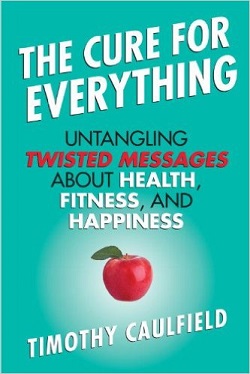
The Cure for Everything: Untangling the Twisted Messages about Health, Fitness and Happiness by Timothy Caulfield, Beacon Press, 2012, available in several formats.
If you have time to read only one book on health this year, I would strongly suggest that it be this one. Were you to be prone to spend money on dietary supplements, cleanses, homeopathy, or acupuncture (to name a few currently popular fad items), you’d make back the money you spend on this book with all the money you’d save by cutting out your expenses on those totally needless items.
A dear friend from a number of years ago (and in a different state from where we live now) said to me about some nostrum or other, “It totally changes the way your body works.” Whoa! Do we actually want to do that? Sounds pretty dangerous to me. (She was safe in taking whatever-it-was, of course, as it did nothing of the kind. Cleaned out her wallet, but that’s about it.) Caulfield actually tries out every item he criticizes, so he puts his money where his mouth is. There’s a hilarious section
in which he gulps down a handful of homeopathic sleeping pills, but he can’t get anyone else to do so, even those who say (rightly) that they’re just sugar pills.
The problem with us humans is that we always want something dramatic and miraculous. We always want to be told that there’s a “cure” out there for whatever ails us, and that if we just find the magic solution we’ll be fine. We’re often drawn to the extreme, especially in the area of diet, but these regimens are never sustainable, and pretty soon we’ve fallen back into our old ways–when a more moderate approach, one that we can actually stick to over the long term, would be far better. (I am not of course talking here about someone with true food allergies, who often has no choice but to adopt a very limited diet or live with–or perhaps die with–the consequences. Read Don’t Kill the Birthday Girl by Sandra Beasley to get a taste of what it’s like to deal with the real thing on a day-to-day basis.)
I’ve written several posts of late about cutting excess sugar out of my diet, most recently about getting through the holidays while abstaining pretty much totally from any desserts or other treats. I’ve eaten very well during this time. (Be sure to read the post later this week over on the hospitality blog when I discuss how to smoke salmon on your stovetop.) But you know what? I think I can relax just a little if I’m careful. Yes, I’m an abstainer, someone who does much better with cutting out a temptation totally rather than indulging moderately, so I don’t want to slide back into my might-as-well-drink-a-can-of-Coke coffee in the morning (6 1/2 teaspoons of sugar, close to the average 7 teaspoons of sugar in a typical can of soda), or my a-small-daily-treat-is-a-good-thing mentality (7 more teaspoons for a regular-size pack of M&M’s), or my it’s-calling-to-me-and-I-can’t-resist-it excuse (responsible for many indulgences, some too embarrassing to admit). A little planning will work wonders. So I’ll go ahead and make a dessert for company and partake of it, but I’ll be careful to make just enough for the occasion itself. (That’s what the French do, apparently–or what they used to do, before American eating habits invaded their sleek and svelte country. A missionary to France told us once that the idea of having a cookie jar is/was foreign to them. A special treat is just that–a special treat.) We’re having company for dinner Sunday, so I plan to make enough of a dessert to yield eight servings. And that’s it. Timothy Caulfield would be proud of me. (He had a habit of eating a bag of peanut M&M’s every time he went to a movie, which could be two or three times a week. Too much! He cut that out.)
Caulfield is also very helpful about exercise and spells out his own program in detail. While I’m just not going to do exactly what he does (mainly because I will only do something if it’s simple) I found his guidelines on what produces actual fitness to be motivating and energizing. I’ve enjoyed going on my 45-50-minute walks several times a week, but I’ve wondered sometimes if I was really building fitness. Well, Caulfield has the answer: if you’re not pushing yourself and getting your heart rate and breathing up, you’re not doing much. Going for a 45-minute walk is much better than sitting for 45 minutes, so it’s still a good idea. But don’t kid yourself that you’re really building up your fitness level. Much better to do something more challenging, at least for most of the time. So I’ve started doing intense bursts on the exercise bike, alternating with slower stretches, and I’ve gotten myself back into doing the pushups, which I hate, along with other core exercises. Now that I realize that I don’t have to do the walk (unless I want to) and the floor stuff on the same day I’m much more willing to be consistent.
This post is running long, so I’ll deal with the whole issue of fad diets in a later post. In the meantime, read this book!
PS If you’d like a taste of Caulfield’s material, you can read this blog post.